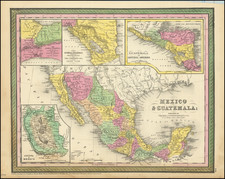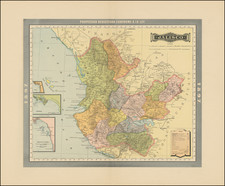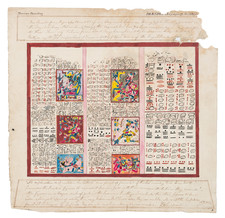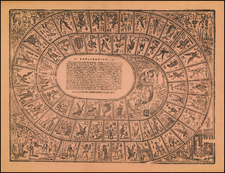One of the Best Depictions of Texas and Gulf Coast in the First Half of the 18th Century
Scarce map of the Texas, Louisiana and the Coast of Mexico and Yucatan, published by Reiner and Josua Ottens in Amsterdam.
The map includes an excellent depiction of the Texas and the Gulf Coast, from the Appalachiola River to the Rio Grande, based upon contemporary sources.
In the interior of Texas, the map shows several roads, including one identified as the route taken by "Mr. S. Denis" in 1716 and 1717, and de La Salle's Fort Francas (established 1685) and Route in 1687. The latter would seem to refer to the expedition of René Robert Cavelier, Sieur de La Salle, which set sail from France in July 1684 in search of the mouth of the Mississippi, in the hopes of starting a colony. La Salle ultimately established a settlement in Texas and is believed to have ventured as far west as the Rio Grande before turning his attention to the east, where he encountered the Hasinai, or Tejas, Indians. On another expedition to the east, his men mutinied and he was killed in an ambush by one of his followers, in March 1687. The La Salle settlement was abandoned. A portion of the settlers made their way to Canada, while six remained among the East Texas Indians and were later captured by the Spaniard Alonso De León, who had led a march from San Francisco de Coahuila, now Monclova, in 1689.
The references to Mr. Saint Denis refer to Louis Antoine Juchereau de St. Denis, a French-Canadian soldier and explorer best known for his exploration and development of the Louisiana (New France) and Spanish Texas regions. Antoine Laumet de La Mothe, Sieur de Cadillac, sent St. Denis in 1713, to travel up the Red River and establish a French outpost and fort in order to protect the boundaries of French Louisiana and to stop Spanish expansion. Late in 1713 he arrived at what is now Natchitoches and built Fort St. Jean Baptiste de Natchitoches, a trading post.
After founding Natchitoches, St. Denis traveled to the lands of the Hasinai and from there to the Rio Grande. At San Juan Bautista, Coahuila, Commander Diego Ramón placed St. Denis under house arrest. Ever resourceful, St. Denis became engaged to Ramón's step-granddaughter, Manuela Sanchez-Navarro. St. Denis was sent to Mexico City where he successfully defended himself and gained the position of commissary officer for an expedition, commanded by Ramón, which was to found Spanish missions in east Texas.
St. Denis returned to San Juan Bautista in April 1717. During his absence, the political situation had shifted due to the death of Louis XIV and the end of the War of Spanish Succession. This made French-Spanish cooperation less desirable, leaving St. Denis to return to La Louisiane. Despite the frostier political climate, the French sent St. Denis to Mexico City again, but he managed to escape being taken prisoner by the Spanish. St. Denis eventually returned to Natchitoches by February 1719. Spanish officials allowed his wife, Manuela, to join him in 1721 and they remained at the French outpost, Le Poste des Cadodaquious, on the Red River until St. Denis' death in 1744.
This is one of six separately published maps, issued over the course of a year 14 months in 1740 and 1741, to capitalize on interest in the War of Jenkin's Ear. The full map was issued with a title sheet, entitled Grand Theatre de la Guerre en Amerique Suivant les Plus Novelles observations des Espagnols, Anglois, Francois & Hollandois, but the sheets were also issued separately, with two sheets also receiving a separate title when offered as a pair, Nova Isthmi Americani, qui et Panamiensis item Dariensis, Tabula.
The sheets from the 6 sheet map were issued as the sheets were completed. The two middle sheets were made available on their own with a separately engraved title, Nova Isthmi Americani, qui et Panamiensis item Dariensis, Tabula, as advertised by Reinier and Joshua Ottens in the Amsterdamsche Courant, on May 12, 1740. The next two sheets were first advertised on October 6, 1740. The full set of 6 sheets was advertised for sale on June 10, 1741, at a price of 48 stuyvers (see Van der Krogt, ' Advertenties').
This map is scarce on the market. We note only a single entry in a dealer catalog in the past 30 years, as reported by AMPR.
The Ottens brothers, Reiner and Joshua, operated a successful printing partnership in the mid-eighteenth century (fl. 1726-1765). They began the venture in 1726, publishing maps and other prints as “R & I Ottens.” They specialized in the reprinting of others’ work, especially Guillaume De L’Isle. In 1750, Reiner died; his soon, also Reiner, took his place, but the firm began listing their works as “Joshua & Reiner Ottens.” The firm lasted until Joshua’s death in 1765. Joshua’s widow, Johanna de Lindt, sold their remaining stock of plates in 1784.










![[Shows Republic of Texas] United States and Texas](https://storage.googleapis.com/raremaps/img/small/101139.jpg)

![The North Coast of the Gulf of Mexico from St. Marks to Galveston . . . 1844 . . . Additions to 1856, including the Surveys of Comr. Powell, Lt. Simmes & Profr. Coffin, U.S. Navy [and] St. Marks to Galveston. Sheet II. . . . 1845. Additions to 1851 . . . .](https://storage.googleapis.com/raremaps/img/small/89497.jpg)

